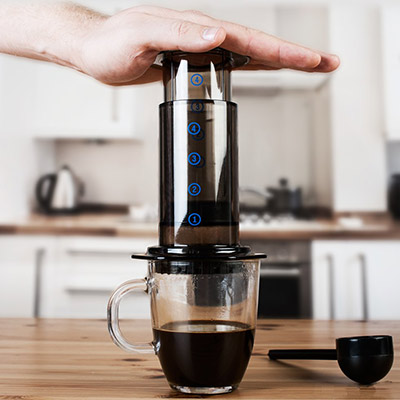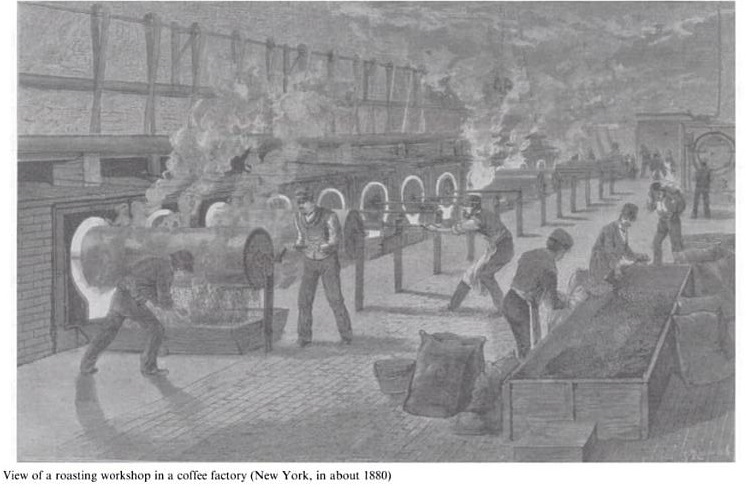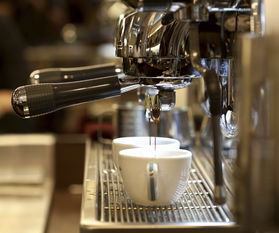Solve the ten common problems of Philharmonic pressure brewing coffee
[guide] question 1: is it better to use Philharmonic filter paper or metal strainer? A: you may not like coffee made from filter paper as much as coffee made from metal filter. The metal mesh allows a lot of sediment and gum to enter the coffee, making the coffee taste heavy and rough, similar to the coffee made by a pressing pot.
Question 1: is it better to use Philharmonic pressure filter paper or metal filter mesh?
A: you may not like coffee made from filter paper as much as coffee made from metal filter. The metal mesh allows a lot of sediment and gum to enter the coffee, making the coffee taste heavy and rough, similar to coffee made by pressing pots. We organized a number of coffee lovers to test that most people like the coffee made by filter paper.
With regard to the Philharmonic filter paper, in fact, all the white filter paper produced today avoids the use of dioxins, the carcinogenic chemicals used to bleach paper in the late 1980s. For this reason, I can confidently recommend using white filter paper instead of brown filter paper. Brown filter paper comes into contact with hot water to release a cardboard smell that may contain suspicious chemicals, including tar.
Problem 2: the coffee made with Elle pressure is so slippery that it feels light. Am I operating incorrectly?
There are three possible answers to this question:
The coffee powder is not fine enough. Finer grinding can produce a stronger taste. If you are using a blade grinder, be sure to run for 20-30 seconds. If you are using a disc grinder or grinding beans in a store, adjust the thickness between drip filtration and Italian style.
The coffee powder you use is not enough. Use a measuring spoon made by the Philharmonic to make sure the taste is optimized.
You are used to bitter coffee, but the less bitter and smoother coffee made by Philharmonic pressure makes you feel lighter. We know that many Philharmonic users now prefer the non-bitter, low-sour espresso made with Philharmonic pressure. If you want to try stronger coffee, just increase the amount of coffee or reduce the amount of hot water to adjust.
Question 3: I have a rotary blade bean grinder. Do I need to buy a more expensive bean grinder that can grind more finely in order to maximize my Philharmonic pressure?
A: we have tested many of these bean grinders and found that the results are also very good. We only need to grind them a little longer than suggested in the manual. You can try a grinding time of two tablespoons for 30 seconds. When the fineness of espresso is reached, pink coffee may stick to the bean grinder because of static electricity. You may need to take out the coffee with the help of a spoon. Two tablespoons of finely ground coffee may require Philharmonic to press and filter for 20-30 seconds. The thicker powder filter makes the coffee a little lighter.
Question 4: to make a regular American coffee with Philharmonic pressure is basically to make an espresso and dilute it with hot water. Why not add more water when making it?
A: we have tried this method, but in the blind taste, every tester thinks that the American coffee made in the way we recommend it tastes smoother. The coffee extracted with too much water is more bitter.
Question 5: Philharmonic pressure recommends using 175F (80 ℃) water, which doesn't seem to be hot enough. Why don't you recommend water close to the boiling point?
A: when we developed Philharmonic pressure, we tested that different water temperatures had more effect on taste than any other test. Our testers range from ordinary coffee drinkers to coffee enthusiasts to professional coffee tasters and consultants. Everyone who took part in the test preferred coffee made from 74 ℃-80 ℃ of water. They say hotter water is fine, but 74 ℃-80 ℃ water makes the best coffee.
It is often recommended that the brewing water temperature be between 91 ℃ and 93 ℃. This temperature is more suitable for the traditional way of brewing coffee powder. In this way, the water temperature drops faster, and the coffee at the bottom comes into contact with a lower water temperature. However, all coffee particles in the Philharmonic pressure come into contact with the same water temperature when stirring.
Don't be confident that your coffee is cold. The hottest coffee anyone can drink is 63 ℃.
Question 6: why is Philharmonic pressure equipped with a mixing rod? Any spoon will be fine.
Answer: the top handle of the Philharmonic pressure mixing rod can prevent the mixing rod from touching the filter paper and will not scratch the cylinder.
Question 7: where can I buy more filter paper?
Answer: each Philharmonic pressure comes with 350 pieces of filter paper, which is enough for you to use for several months. A supplement of 350 pieces of filter paper is available at many retailers that sell Philharmonic pressure, including on Taobao.
Question 8: how to make pressing easier?
A: there are two possible answers to this question.
People who find the Philharmonic pressure difficult to press are often because they press too hard. When you start pressing, press the pressure bar 1 cm and then stop. Let the compressed air in the cylinder help you. After a few seconds, press the pressure bar a little more and stop. Repeat until you hear the sound of the air coming out of the cylinder symbolizing that all the liquid has been filtered out. Now it's easy to press the pressure bar down and press the coffee powder into a cake.
If gentle pressing still doesn't solve it, your coffee powder may be too fine or some of it may be too fine. If you use a blade grinder to grind the powder, shorten the grinding time slightly. If you are using a disc grinder or grinding in a store, you can thicken the thickness by one scale.
Question 9: why does the mixture of water and coffee powder swell and spill when I add 3-4 tablespoons of water?
A: this can happen when using very freshly roasted ground coffee and a water temperature higher than the recommended 80 ℃. Try 80 ℃ or even 85 ℃ of water and the situation disappears. If you prefer hotter water and its bitterness, use 3 or even 2 tablespoons of water at a time.
Question 10: is there any trick to boil the water to the desired temperature, such as the recommended 80 ℃?
A: there are a few suggestions.
The most common and easiest way is to boil water in a microwave oven. Measure the amount of water you need and put it in a cup or other container (there is a scale on the cylinder and can be used as a measuring cup.) And then heat it in the microwave. Use a kitchen thermometer (a common thermometer used when cooking meat) to determine the number of seconds it takes to heat water to a certain temperature (don't put the thermometer in the microwave). You don't need a thermometer for future heating, just remember how long it takes to heat a specific amount of water to the desired temperature.
One way is to measure a certain amount of boiling water, and then add cold water to reduce the temperature to 80 ℃. Pour boiling water into the measuring cup, then add the right amount of cold water to increase the total amount of water by 1/3. For example, if you add 1.5 cups of boiled water, add cold water to bring the water level to 2 cups.
Another way is to pour boiling water into a cold cup and leave it for about 1 minute. This will lower the temperature of the water and preheat your cup. Then pour the water used in the pressure filter into the pressure bar. As a result, both the water cup and the pressure bar help lower the temperature of the water (you can verify it with a kitchen thermometer) now pour the water from the pressure rod into the pressure cylinder. Now you can press the water into a water cup to make an American coffee or an empty cup to make espresso.
Many domestic "overheating" systems provide 80 ℃ of water or can be adjusted to that temperature. If you have such a hot water system, it is really easy to use the Philharmonic pressure. Some electric kettles boil water quickly and can adjust the water temperature. You can set the desired temperature and then boil the water.

Important Notice :
前街咖啡 FrontStreet Coffee has moved to new addredd:
FrontStreet Coffee Address: 315,Donghua East Road,GuangZhou
Tel:020 38364473
- Prev

Where does the aroma of coffee come from? Why is it so attractive?
A few days before Napoleon died on St. Helena Island in 1821, his attendant Marshal Bertrand wrote about Napoleon begging: "he asked for twenty times in the morning and asked me if I could give him some more coffee. "No, sir, the doctor ordered only one spoonful. A few days before Napoleon died on St. Helena Island in 1821, his attendant Marshal Bertrand
- Next

How to use espresso machine correctly
The coffee machine should be more than 10 cm away from the wall, otherwise it will affect the heat dissipation of the machine; the ground on which the coffee machine is placed should be as flat as possible, otherwise the ground level support is not good, which will cause the noise and poor operation of the machine; the coffee machine is best placed in a dry, ventilated room; it is best to use a special bottom cabinet for the coffee machine below the machine, in line with the height of the human body. Coffee machine before use
Related
- What is the meaning of lactic acid fermentation with coffee bean treatment?
- How to judge the state of foam by sound?
- How does the latte pull out the unicorn pattern? Come to get for a little trick to improve the flower pull!
- Will flower pulling affect the taste of the latte?
- Do you know the history of coffee?
- The difference between honey treatment and sun washing what is raisin honey treatment?
- What kind of milk can a novice use to make coffee foam to keep the foam longer? The correct method and skills of milking tutorial sharing
- Why do washed coffee beans taste sour? Flavor characteristics of washed Coffee
- Introduction to the skill of how to practice the size and height of water injection around the circle of hand-brewed coffee
- How do beginners practice coffee flower drawing from scratch?

